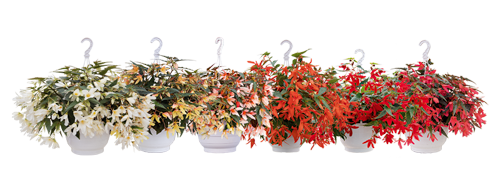

Groovy
See the Difference!
- The most uniform Begonia boliviensis seed selection on the market
- Mounded, semi-trailing plant habit
- Large single flowers in clear, intense colors
- Very uniform flowering across the series
- High germination rate and plug performance
Technical Guide: Click here
All information in our technical guide is based on our own trials and would therefore be as guideline only. Detailed cultivation aspects vary depending on climate, location, time of year and environmental conditions. Benary expressly disclaims any responsibility for the content of such data/information and makes no representation or warranty for the cultivation of any products listed. It is recommended that growers conduct a trial of products under their own conditions.
- Crop Time
- Spring: 14 - 16 weeks
- Height ∅
- 14 ″ / 35 cm
- Width ∅
- 9 ″ / 23 cm
- Exposure
- Sun - Shade
- Seed Form
- Pelleted Seed
- Best Uses
- Bedding, Hanging basket, Landscape, Pot Plant
Culture guide
Usage
Pots, Hanging Baskets, Mixed Containers, Packs and Landscape
Sowing method
1-2 pellets per plug. No covering required.
Germination
Optimum conditions for seedling development, beginning on the day of sowing until radicle emergence. Expect radicle emergence in 7–10 days. Germination should be complete at 10 days unless optimum conditions are not provided. Humidity should be between 95-100 % until day 11; then dehumidify and reduce to 60 %.
Growing on
Obligate long day plant requiring a daylength > 13.5 hours to initiate flowering. A night break can also be used, lighting for 5 hrs. during the night from 10 pm-3 am.
Media
Plug culture: pH 5.5-5.8; EC 0.5; Begonias are sensitive to high salt levels. Use a media low in soluble salts. Begin with a media moisture level of saturated (5) from day 1–11. A saturated media and high humidity is critical to successful begonia germination. Beginning day 12, alternate between moisture levels wet (4) and moist (3).
Growing on: Use a well-drained, growing substrate. pH 5.5–5.8; EC 1.0-1.5. Alternate between moisture levels wet (4) and medium (2).
Temperature
Plug culture: 72–74°F (22-23˚C) until radicle emergence. Higher temperatures, exceeding 80°F (27°C) will inhibit germination. Upon radicle emergence, on day 10-14 reduce the temperature to 68–70°F (20–21°C) until cotyledon expansion has occured. On day 21 the temperature can be reduced further to 68°F (20°C). For irrigation use tempered water (above 64°F / 18°C) only.
Growing on: After transplanting 65–68 °F (18–20°C) nights for the first 14 days or until the roots reach the bottom of the container. Thereafter temperatures may be lowered to 62–64°F (17–18°C). An ADT (average daily temperature of 67°F (19˚C) will give the fastest finished crop. Temperatures below 57°F (14˚C) will result in tuber fomation and a delay of the crop. A DIFF of 34-36°F (2-3°C) will result in a more compact crop requiring little to no growth regulators.
Fertilization
Plug culture: Begin fertilizing early once germination is complete, approximately day 14. Lower rates of feeding at 50 ppm 2-3 times per week will help to size up the seedlings. Under higher light conditions use a 20-10-20 fertilizer and under lower light a 17-5-17.Once seedlings are established the 17-5-17 fertilizer works well. Include a micro nutrient package to give adequeste supply of minor elements.
Growing on: Alternate between Calcium based fertilizer 14-4-14 and an Ammonium fertilizer 17-5-17 at 100–150 ppm. Keep the media EC at 1.5. Application of Potassium nitrate can help to keep the plants more compact. Under higher light and warmer temperatures a fertilizer with additional ammonium can be used. Tall, stretched plants with few flowers indicate too much ammonium. Stunted, chlorotic plants with marginal leaf burn indicate a lack of calcium and magnesium. Under high light and extended daylength an ammonium-based feed (20-10-20) at 100-150 ppm nitrogen can also be used
Stage I Starts with the radicle breaking through the testa. The roots are touching the medium. Ends with fully developed cotyledons.
Stage II Starts from fully developed cotyledons. Ends with the fully developed true leaf or true leaf pair.
Stage III Starts from the fully developed true leaf or true leaf pair and ends with 80% of the young plants being marketable.
Stage IV All young plants are ready for sale and in the process of being hardened off. This stage lasts about 7 days.
The cultural recommendations are based on results from trials conducted under Central European conditions. Different conditions in other parts of the world may lead to deviations in results achieved.






